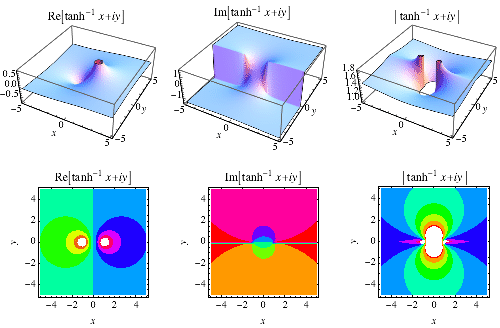


 تاريخ الرياضيات
تاريخ الرياضيات
 الرياضيات في الحضارات المختلفة
الرياضيات في الحضارات المختلفة 
 الرياضيات المتقطعة
الرياضيات المتقطعة
 الجبر
الجبر
 الهندسة
الهندسة 
 المعادلات التفاضلية و التكاملية
المعادلات التفاضلية و التكاملية 
 التحليل
التحليل
 علماء الرياضيات
علماء الرياضيات |
Read More
Date: 18-6-2019
Date: 25-4-2019
Date: 13-8-2018
|

 |
The inverse hyperbolic tangent  (Zwillinger 1995, p. 481; Beyer 1987, p. 181), sometimes called the area hyperbolic tangent (Harris and Stocker 1998, p. 267), is the multivalued function that is the inverse function of the hyperbolic tangent.
(Zwillinger 1995, p. 481; Beyer 1987, p. 181), sometimes called the area hyperbolic tangent (Harris and Stocker 1998, p. 267), is the multivalued function that is the inverse function of the hyperbolic tangent.
The function is sometimes denoted  (Jeffrey 2000, p. 124) or
(Jeffrey 2000, p. 124) or  (Gradshteyn and Ryzhik 2000, p. xxx). The variants
(Gradshteyn and Ryzhik 2000, p. xxx). The variants  or
or  (Harris and Stocker 1998, p. 263) are sometimes used to refer to explicit principal values of the inverse hyperbolic tangent, although this distinction is not always made. Worse yet, the notation
(Harris and Stocker 1998, p. 263) are sometimes used to refer to explicit principal values of the inverse hyperbolic tangent, although this distinction is not always made. Worse yet, the notation  is sometimes used for the principal value, with
is sometimes used for the principal value, with  being used for the multivalued function (Abramowitz and Stegun 1972, p. 87). Note that in the notation
being used for the multivalued function (Abramowitz and Stegun 1972, p. 87). Note that in the notation  ,
,  is the hyperbolic tangent and the superscript
is the hyperbolic tangent and the superscript  denotes an inverse function, not the multiplicative inverse.
denotes an inverse function, not the multiplicative inverse.
The principal value of  is implemented in the Wolfram Language as ArcTanh[z] and in the GNU C library as atanh(double x).
is implemented in the Wolfram Language as ArcTanh[z] and in the GNU C library as atanh(double x).

The inverse hyperbolic tangent is a multivalued function and hence requires a branch cut in the complex plane, which the Wolfram Language's convention places at the line segments ![(-infty,-1]](http://mathworld.wolfram.com/images/equations/InverseHyperbolicTangent/Inline12.gif) and
and  . This follows from the definition of
. This follows from the definition of  as
as
![tanh^(-1)z=1/2[ln(1+z)-ln(1-z)].](http://mathworld.wolfram.com/images/equations/InverseHyperbolicTangent/NumberedEquation1.gif) |
(1) |
The inverse hyperbolic tangent is given in terms of the inverse tangent by
 |
(2) |
(Gradshteyn and Ryzhik 2000, p. xxx). For real  , this simplifies to
, this simplifies to
 |
(3) |
The derivative of the inverse hyperbolic tangent is
 |
(4) |
and the indefinite integral is
 |
(5) |
It has special values
 |
 |
 |
(6) |
 |
 |
 |
(7) |
 |
 |
 |
(8) |
 |
 |
 |
(9) |
It has Maclaurin series
 |
 |
 |
(10) |
 |
 |
 |
(11) |
 |
 |
 |
(12) |
 |
 |
 |
(13) |
(OEIS A005408).
An indefinite integral involving  is given by
is given by
 |
 |
![ln[(sqrt(a+bx)-sqrt(a))/(sqrt(a+bx)+sqrt(a))]](http://mathworld.wolfram.com/images/equations/InverseHyperbolicTangent/Inline43.gif) |
(14) |
 |
 |
![ln[((sqrt(a+bx)-sqrt(a))^2)/((a+bx)-a)]](http://mathworld.wolfram.com/images/equations/InverseHyperbolicTangent/Inline46.gif) |
(15) |
 |
 |
![ln[((2a+bx)-2sqrt(a(a+bx)))/(bx)]](http://mathworld.wolfram.com/images/equations/InverseHyperbolicTangent/Inline49.gif) |
(16) |
 |
 |
 |
(17) |
when  .
.
REFERENCES:
Abramowitz, M. and Stegun, I. A. (Eds.). "Inverse Hyperbolic Functions." §4.6 in Handbook of Mathematical Functions with Formulas, Graphs, and Mathematical Tables, 9th printing. New York: Dover, pp. 86-89, 1972.
Beyer, W. H. CRC Standard Mathematical Tables, 28th ed. Boca Raton, FL: CRC Press, pp. 142-143, 1987.
GNU C Library. "Mathematics: Inverse Trigonometric Functions." http://www.gnu.org/manual/glibc-2.2.3/html_chapter/libc_19.html#SEC391.
Gradshteyn, I. S. and Ryzhik, I. M. Tables of Integrals, Series, and Products, 6th ed. San Diego, CA: Academic Press, p. xxx, 2000.
Harris, J. W. and Stocker, H. Handbook of Mathematics and Computational Science. New York: Springer-Verlag, 1998.
Jeffrey, A. "Inverse Trigonometric and Hyperbolic Functions." §2.7 in Handbook of Mathematical Formulas and Integrals, 2nd ed.Orlando, FL: Academic Press, pp. 124-128, 2000.
Sloane, N. J. A. Sequence A005408/M2400 in "The On-Line Encyclopedia of Integer Sequences."
Spanier, J. and Oldham, K. B. "Inverse Trigonometric Functions." Ch. 35 in An Atlas of Functions. Washington, DC: Hemisphere, pp. 331-341, 1987.
Zwillinger, D. (Ed.). "Inverse Hyperbolic Functions." §6.8 in CRC Standard Mathematical Tables and Formulae. Boca Raton, FL: CRC Press, pp. 481-483, 1995.



|
|
|
|
تفوقت في الاختبار على الجميع.. فاكهة "خارقة" في عالم التغذية
|
|
|
|
|
|
|
أمين عام أوبك: النفط الخام والغاز الطبيعي "هبة من الله"
|
|
|
|
|
|
|
قسم شؤون المعارف ينظم دورة عن آليات عمل الفهارس الفنية للموسوعات والكتب لملاكاته
|
|
|